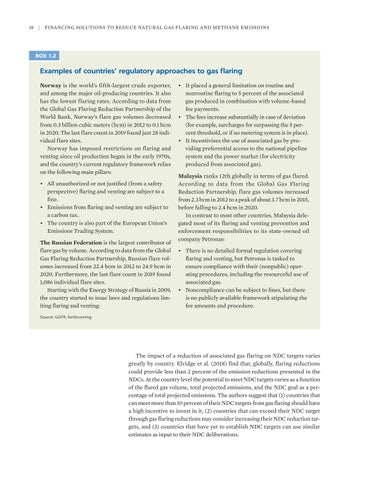18
| Financing Solutions to Reduce Natural Gas Flaring and Methane Emissions
BOX 1.2
Examples of countries’ regulatory approaches to gas flaring Norway is the world’s fifth-largest crude exporter, and among the major oil-producing countries. It also has the lowest flaring rates. According to data from the Global Gas Flaring Reduction Partnership of the World Bank, Norway’s flare gas volumes decreased from 0.3 billion cubic meters (bcm) in 2012 to 0.1 bcm in 2020. The last flare count in 2019 found just 28 individual flare sites. Norway has imposed restrictions on flaring and venting since oil production began in the early 1970s, and the country’s current regulatory framework relies on the following main pillars: • All unauthorized or not justified (from a safety perspective) flaring and venting are subject to a fine. • Emissions from flaring and venting are subject to a carbon tax. • The country is also part of the European Union’s Emissions Trading System. The Russian Federation is the largest contributor of flare gas by volume. According to data from the Global Gas Flaring Reduction Partnership, Russian flare volumes increased from 22.4 bcm in 2012 to 24.9 bcm in 2020. Furthermore, the last flare count in 2019 found 1,086 individual flare sites. Starting with the Energy Strategy of Russia in 2009, the country started to issue laws and regulations limiting flaring and venting:
• It placed a general limitation on routine and nonroutine flaring to 5 percent of the associated gas produced in combination with volume-based fee payments. • The fees increase substantially in case of deviation (for example, surcharges for surpassing the 5 percent threshold, or if no metering system is in place). • It incentivizes the use of associated gas by providing preferential access to the national pipeline system and the power market (for electricity produced from associated gas). Malaysia ranks 12th globally in terms of gas flared. According to data from the Global Gas Flaring Reduction Partnership, flare gas volumes increased from 2.3 bcm in 2012 to a peak of about 3.7 bcm in 2015, before falling to 2.4 bcm in 2020. In contrast to most other countries, Malaysia delegated most of its flaring and venting prevention and enforcement responsibilities to its state-owned oil company Petronas: • There is no detailed formal regulation covering flaring and venting, but Petronas is tasked to ensure compliance with their (nonpublic) operating procedures, including the resourceful use of associated gas. • Noncompliance can be subject to fines, but there is no publicly available framework stipulating the fee amounts and procedure.
Source: GGFR, forthcoming.
The impact of a reduction of associated gas flaring on NDC targets varies greatly by country. Elvidge et al. (2018) find that, globally, flaring reductions could provide less than 2 percent of the emission reductions presented in the NDCs. At the country level the potential to meet NDC targets varies as a function of the flared gas volume, total projected emissions, and the NDC goal as a percentage of total projected emissions. The authors suggest that (1) countries that can meet more than 10 percent of their NDC targets from gas flaring should have a high incentive to invest in it, (2) countries that can exceed their NDC target through gas flaring reductions may consider increasing their NDC reduction targets, and (3) countries that have yet to establish NDC targets can use similar estimates as input to their NDC deliberations.


